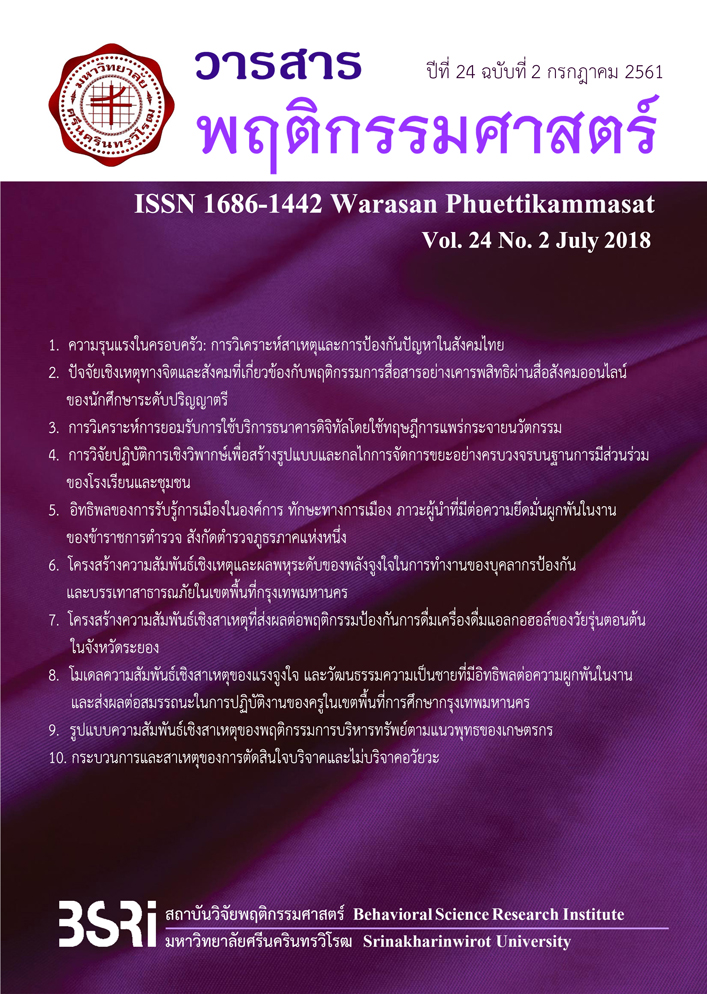โมเดลความสัมพันธ์เชิงสาเหตุของแรงจูงใจ และวัฒนธรรมความเป็นชายที่มีอิทธิพล ต่อความผูกพันในงาน และส่งผลต่อสมรรถนะในการปฏิบัติงานของครู ในเขตพื้นที่การศึกษากรุงเทพมหานคร
Keywords:
causal relationship model, motivation, masculine culture, job engagement, performance competencyAbstract
The aim of this research was to develop the causal relationship model of motivation and masculine culture influencing teachers’job engagement and performance competency in Bangkok Educational Service Areas. The researcher applied the mixed methods research approach using a quantitative approach for the major research and a qualitative approach for additional research. Questionnaires were distributed to 272 samples as part of the quantitative research who are teachers under the Office of the Basic Education Commission (OBEC) in Bangkok Educational Service Areas.Key informants of qualitative research were the former group of 12 teachers. Research tools included questionnaires and interviews. Data analysis was conducted using a computer program, LISREL, and content analysis. Statistics used for the research included frequency, percent, arithmetic mean, standard deviation and other statistical values relating to structural equation modeling. The findings were as follows: 1) The results of the quantitative analysis revealed that 75% of performance competency was a result of motivation, masculine culture and job engagement. Key variables that have the greatest effect are job engagement, followed by masculine culture. However, motivation has a direct positive effect but does not have statistical significance. 2) The results of the qualitative research indicated that the variables relating to teachers’ performance capacity consisted of a) motivation, such as financial reward, b) organizational culture, e.g., brotherhood, c) job engagement, e.g., physical support,
d) performance competency, namely teaching skills. 3) A comparison of the quantitative research and qualitative research found that four studied variables did not have similar issues but different ones. They were: 1) motivation -different issues are work importance and financial rewards, 2) Masculine culture -different issues are masculine culture and brotherhood culture, 3) Job engagement - different issues are psychological safety (guarantees) and physical support; and 4) Performance competency - different issues are job role perception and teaching skills.
Downloads
References
ไชยา ยิ้มวิไล. (2557). พัฒนาการรัฐประศาสนศาสตร์และบริหารรัฐกิจ: จากอดีตสู่ปัจจุบันและอนาคต. กรุงเทพฯ: สำนักพิมพ์มหาวิทยาลัยศรีปทุม.
วิริณธิ์ ธรรมนารถสกุล. (2547). ปัจจัยเชิงสาเหตุพหุระดับของผลการปฏิบัติงานของพยาบาลวิชาชีพ: ศึกษาปัจจัยสภาพแวดล้อมในการทำงาน และปัจจัยระดับบุคคล. (วิทยานิพนธ์ปริญญาดุษฎีบัณฑิต). มหาวิทยาลัยศรีนครินทรวิโรฒ, กรุงเทพมหานคร.
สำนักพัฒนาระบบบริหารงานบุคคลและนิติการ สำนักงานคณะกรรมการการศึกษาขั้นพื้นฐาน. (2553). คู่มือเส้นทางครูมืออาชีพสำหรับครูผู้ช่วย. กรุงเทพฯ: โรงพิมพ์ชุมนุมสหกรณ์การเกษตรแห่งประเทศไทย จำกัด.
Alkhalaf, A. H. (2017). Identifying employee engagement factors in the oil and energy industry in Saudi Arabia. (doctoral dissertation). Pennsylvania State University, Pennsylvania.
Armstrong, M., &Taylor, S. (2014). Armstrong’s handbook of human resource management practice. 13th ed. London: Kogan Page.
Byars, L. L., & Rue, L. W. (2008). Human resource management. 9th ed. New York: McGraw-Hill.
Chien, H. C. (1984). A comparison of teacher educators’ perceptions of expected performance with student teachers’ perceptions of actual performance in Taiwan. (doctoral dissertation). University of Georgia, Georgia.
Colquitt, J. A., Lepine, J. A., & Wesson, M. J. (2009). Organizational behavior: Improving performance and commitment in the workplace. New York: McGraw-Hill.
Coombs, A. J. (2017). Teacher educators’ approaches to assessment. (Master’s thesis). Queen’s University, Ontario.
Cooper, K. E. (2009). Go with the flow: Examining the effects of engagement using flow theory and its relationships to achievement and performance in the 3-dimensional virtual learning environment of second life. (doctoral dissertation). University of Central Florida, Florida.
Gerson, R. F., & Gerson, R. G. (2006). Positive performance improvement: A new paradigm for optimizing your workforce. CA: Davies-Black Publishing.
Greenberg, J. (2011). Behavior in organizations. 10th ed. Harlow: Pearson Education.
Hofstede, G., Hofstede, G. J., & Minkov, M. (2016). National culture. Retrieved from https://geert-hofstede.com/national-culture.html
Kahn, W. A. (1990). Psychological conditions of personal engagement and disengagement at work. Academy of Management Journal, 33(4), 692-724.
Rai, R. (2015). Building employee engagement through organizational culture: An empirical study of Indian IT industry. Prestige International Journal of Management and Research, 8(9), 15-20.
Shahzad, F., Iqbal, Z., & Gulzar, M. (2013). Impact of organizational culture on employees job performance: An empirical study of software houses in Pakistan. Journal of Business Studies Quarterly, 5(2), 56-64.
Shu, Y. (2015). The impact of intrinsic motivation on the effectiveness of leadership style towards on work engagement. Contemporary Management Research, 11(4), 327-350.
Springer, G. J. (2011). A study of job motivation, satisfaction, and performance among bank employees. Journal of Global Business, 5(1), 29-42.
Wilcox, K. E. (1979). Motivation, central life interests, voluntarism, and demographic variables as predictors of job satisfaction and perceived performance of teachers. (doctoral dissertation). University of Kansas, Kansas.
Williams, R. S. (2002). Managing employee performance: Design and implementation in organizations. London: Thomson Learning.
Yousaf, A., Yang, H., & Sanders, K. (2015). Effect of intrinsic and extrinsic motivation on task and contextual performance of Pakistani professionals: The mediating role of commitment foci. Journal of Managerial Psychology, 30(2), 133-150.
Downloads
Published
How to Cite
Issue
Section
License
Behavioral Science Research Institute, SWU
114 Sukhumvit 23, Bangkok 10110, Thailand.
Tel.02-649-5000 # 17600



